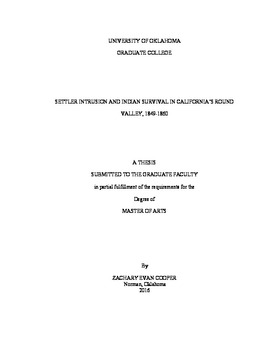| dc.contributor.advisor | Metcalf, R. Warren | |
| dc.contributor.author | Cooper, Zachary Evan | |
| dc.date.accessioned | 2016-05-13T21:43:34Z | |
| dc.date.available | 2016-05-13T21:43:34Z | |
| dc.date.issued | 2016 | |
| dc.identifier.uri | https://hdl.handle.net/11244/34696 | |
| dc.description.abstract | Scholars currently focusing on white-Indian relations in California are involved in a polarized debate regarding genocide in the state. While this scholarship has undoubtedly brought forth new research and viewpoints on white settlers’ actions in nineteenth-century California, it often strays from what actually happened to both white settlers and Indians in particular areas and instead focuses on proving that particular author’s definition of genocide. This study intends to re-focus scholars on what motivated white settlers to intrude on a government-sponsored Indian reservation and how Indian slavery furthered these settlers’ benefits from the reservation. The government established the Nome Cult Farm and confined Indians inside its borders, yet made no considerable effort to enforce these borders upon white intruders seeking agricultural and labor resources. White settlers not only benefitted from the agricultural resources in the Round Valley, they used unfree Indian labor to do so. | en_US |
| dc.language | en_US | en_US |
| dc.subject | Round Valley | en_US |
| dc.subject | California Indians | en_US |
| dc.subject | California Gold Rush | en_US |
| dc.subject | Indian Farm | en_US |
| dc.title | Settler Intrusion and Indian Survival in California's Round Valley, 1849-1860 | en_US |
| dc.contributor.committeeMember | Wrobel, David M. | |
| dc.contributor.committeeMember | Evans, Sterling | |
| dc.date.manuscript | 2016 | |
| dc.thesis.degree | Master of Arts | en_US |
| ou.group | College of Arts and Sciences::Department of History | en_US |
| shareok.nativefileaccess | restricted | en_US |
